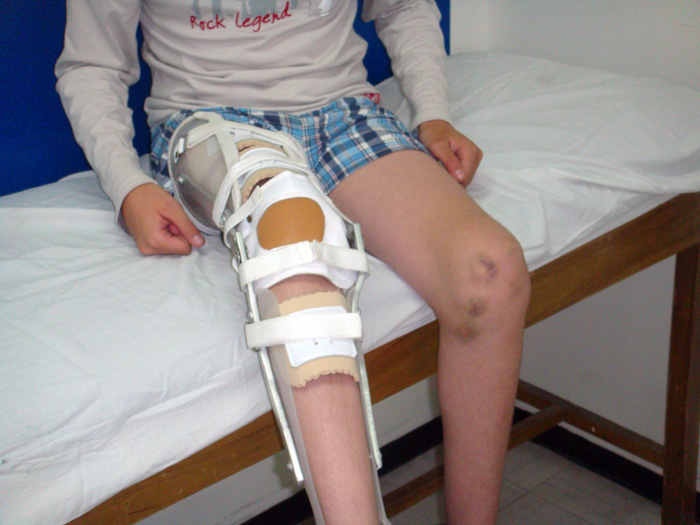The key: interdisciplinary work based on rehabilitation along with a treatment technique different from that used by EPSs.
Blood coagulation depends on various structures such as substances called "coagulation factors" from which 13 have been scientifically identified.
Hemophilia is produced by a genetic mutation (in the X chromosome, one of the sex chromosomes in humans) transmitted by the mother side and affecting men exclusively.
The X chromosome contains the genetic information about the coagulation factor VIII (a fundamental factor for clot creation), and if the chromosome mutates, the factor fails. Depending on the degree of mutation, hemophilia that is produced can be mild, moderate or severe.
*Carlos" case is an example. He was diagnosed with severe hemophilia when he was born; he"s 7 year old now and thanks to his parent"s perseverance and studies from Universidad Nacional de Colombia in La Misericordia Hospital, he can walk, play, practice sports (with precaution) and go to school, although predictions indicated he was going to spend his life on a wheelchair.
But, why on a wheelchair" Because people with severe hemophilia, especially when it is moderate or severe, suffer from a common phenomenon called hemarthrosis, which is an internal bleeding of the joints. When this bleeding occurs, bone joints change completely. Their contact with the blood"s iron, due to hemorrhage, makes them swallowed producing a lot of pain and impeding their movement.
Universidad Nacional de Colombia"s work
The general treatment in the country consist exclusively on the application of factor VIII (a coagulation substance), when hemorrhage occurs. This procedure is used regularly in emergencies and it is what permits blood to coagulate and the patient to stop bleeding. The medication cost ($ 3 million COP per ampoule) is covered by the EPS; however, some patients sometimes need more than one per hemorrhage episode.
"We use a different process called prophylaxis, which has shown better social and economic results," says Silverio Castaño, a pediatric oncohematologyst at La Misericordia Hospital and the director of the research group from Universidad Nacional de Colombia.
It consist on the application of Factor VIII tree times per week in children diagnosed with severe hemophilia, from the age of 2 , until they turn 18. This treatment is preventive and permanently used, that is to say, it is used to prevent the hemorrhages, not to stop them when they happen. Its success has been proved from the 1970s by Swedish scientist.
At first, the cost seem to be high, but the results obtained by the Swedish in an investigation that took years, showed that 50% of the children treated with this procedure never experienced bleeding again during their adult life. The other half experienced only five episodes of bleeding per year. A person with hemophilia, without the treatment, experiences at least 5 episodes of bleeding per week.
Universidad Nacional de Colombia began this treatment with a group of twelve children in 2000 (nowadays they are seventy), and they have obtained excellent results since, additionally to prophylaxis, the treatment has been complemented with the work of professional orthopedist and physiatrist that look after patients in each hemorrhage episode; In addition, they have nurses, nutritionists, dentists, geneticists, and psychologists to help patients to suffer the least damage during the hemorrhage episodes.
This interdisciplinary team is essential since they can treat not only hemorrhage but also four more medical conditions such as false tumors, which need immediate surgery by an orthopedist.
A simple tooth extraction implies hospitalizing the patient, so children with hemophilia must have an impeccable oral health. Besides, there is a deformation of the knee joints in 50% of the cases of children with severe hemophilia. In this case conventional therapy do not work, that is why Doris Valencia, a physiatrist from Universidad Nacional de Colombia, has established the use of orthopedic devices to reduce deviations in a non-invasive way with positive results.
"We work in different areas, from nutrition to odontology, since any complication in a child with hemophilia costs many million and it can ruin the work of many years," says Castaño.
Advancements vs. costs
Despite of scientific evidence, prophylaxis is not globally used in the country neither particular interdisciplinary groups to treat these patients, since these professional teams are almost inexistent.
The battle against the health system is huge, since EPSs do not provide the medicine, as it happened to Carlos. He was moved to a hospital where the appropriate medical equipment does not exist, and his parents were suggested to reduce the medicine dose since doctors consider it is exaggerated giving the medicine to patients as a preventive procedure.
"A patient with hemophilia, without proper treatment, gets completely rigid and doomed to live on a wheel chair. This is a really expensive situation for society. The interdisciplinary management that we have, allows us to improve life conditions for patients with hemophilia. They end up being almost healthy, without limitations or sequels, integrated to school life and with big possibilities to be productive," says the oncohematologyst from Universidad Nacional de Colombia.
*due to the parents" request, the minor"s name was changed.
 Correo Electrónico
Correo Electrónico
 DNINFOA - SIA
DNINFOA - SIA
 Bibliotecas
Bibliotecas
 Convocatorias
Convocatorias
 Identidad UNAL
Identidad UNAL



